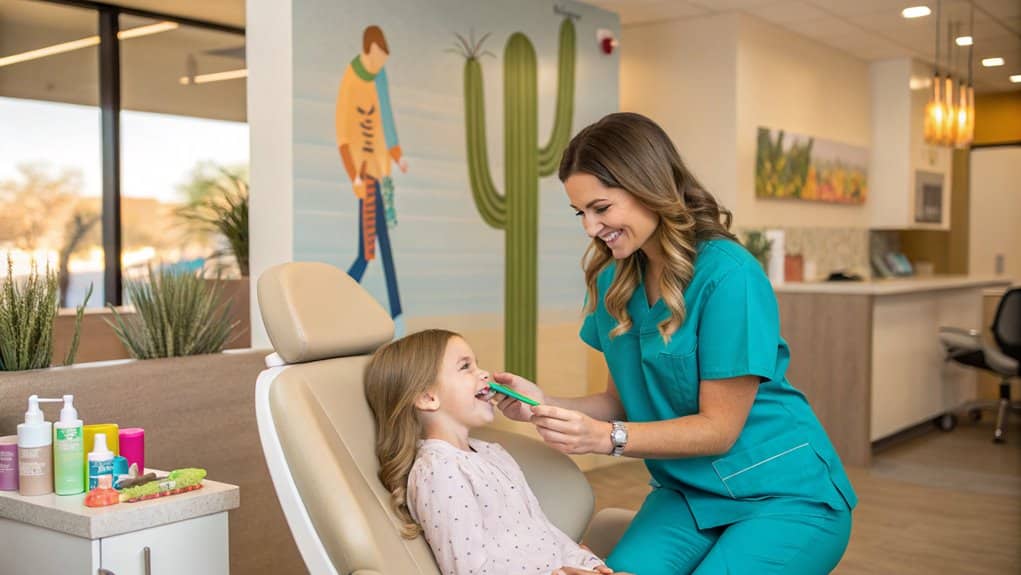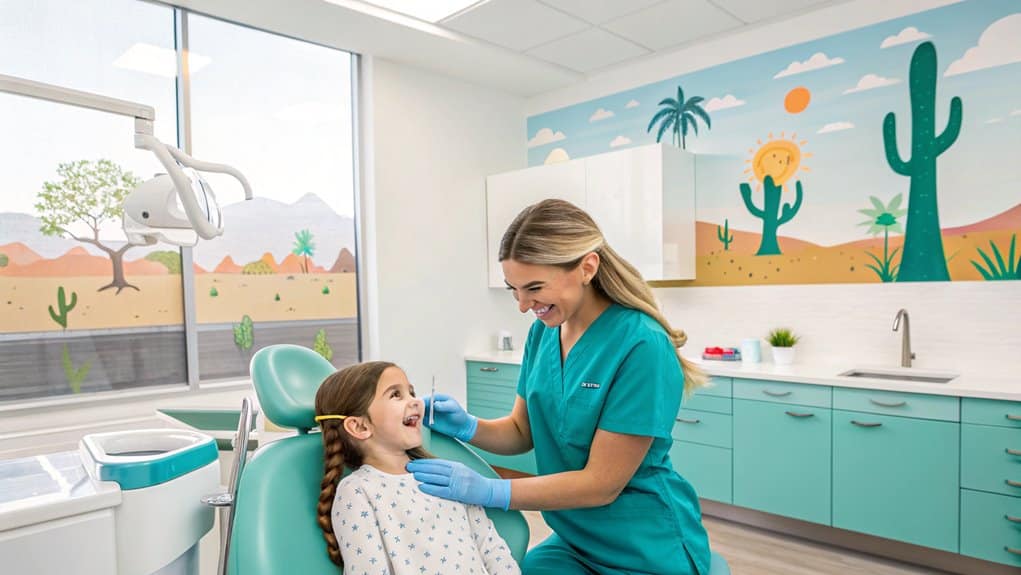Advanced Strategies for Optimizing Pediatric Dental Visit Frequency in Scottsdale’s Growing Communities
Quick Take: Discover how personalized risk assessments and digital innovations are transforming pediatric dental visit schedules to meet Scottsdale’s diverse community needs effectively.
Determining how often children should visit the dentist in Scottsdale involves more than following standard guidelines. Pediatric dentists must consider each child’s health risks, family circumstances, and cultural background to create a balanced care plan that prevents dental problems while staying practical and accessible.
Modern dental care now relies on precision tools like digital x-rays and intraoral cameras, supported by family education and culturally aware communication. By understanding insurance options and community resources, providers can help families keep up with affordable, consistent appointments—ensuring every child in Scottsdale receives equitable, effective oral care.
Key Takeaways
- Use risk-based scheduling by applying advanced assessment models to tailor visit frequency according to each child’s unique dental health profile.
- Leverage digital tools such as intraoral cameras and data integration platforms to improve monitoring and make timely adjustments to appointment intervals.
- Factor in cultural nuances relevant to Scottsdale’s diverse communities when designing visit schedules and communication plans.
- Develop flexible scheduling systems that align with insurance guidelines while ensuring high-risk patients receive more frequent care.
- Partner with local schools and health centers to enhance access and support consistent dental care routines.
Risk Assessment Models for Personalized Visit Schedules
Quick Take: Personalized dental visit schedules leverage advanced risk assessment models to optimize preventive care for children based on comprehensive factors, improving oral health outcomes by tailoring appointment frequency to individual needs.
Dental professionals increasingly rely on sophisticated risk assessment frameworks to design customized visit intervals that reflect each child’s unique oral health profile. These models integrate genetic markers, behavioral patterns, and environmental influences to predict caries susceptibility and other dental risks with greater precision. Such data-driven personalization enhances early intervention strategies and resource allocation, ultimately reducing the incidence of cavities and oral diseases.
These risk assessment tools incorporate a multidimensional view that extends beyond clinical symptoms to include socioeconomic and familial contexts, ensuring holistic care planning. This means children identified as high-risk receive more frequent monitoring and tailored preventive measures, while those at low risk benefit from less frequent but still effective checkups. That’s why integrating models like CAMBRA, Cariogram, ADA, and AAPD into routine dental evaluations is critical for maximizing both patient outcomes and care efficiency.
Key factors embedded in these dental risk assessment models include:
- Genetic predisposition highlighting inherited susceptibility to dental caries and enamel defects.
- Oral hygiene behaviors such as brushing frequency, technique, and use of fluoride products.
- Nutritional influences, emphasizing sugar consumption patterns and cariogenic diet impact.
- Familial dental health history, reflecting parental experiences and preventive habits.
- Socioeconomic determinants, including family income and access barriers affecting treatment adherence.
- Environmental factors like fluoride exposure in community water systems and local dental care accessibility.
Understanding these nuanced variables empowers dentists to create evidence-based, individualized visit schedules that align with evolving risk profiles. Adopting such personalized frameworks cultivates proactive oral health management, fostering patient engagement and optimizing preventive care pathways. By embracing these comprehensive assessment models, caregivers and clinicians can confidently tailor visit frequencies to safeguard children’s smiles effectively. Additionally, integrating early evaluation strategies can further enhance the effectiveness of personalized dental care plans.
Digital Technology’s Role in Visit Frequency Optimization
Key Insight: Digital technologies are transforming pediatric dental care by enabling safer, more personalized visit schedules that optimize treatment efficiency and patient comfort. Integrating advanced imaging, diagnostic tools, and patient engagement platforms empowers dental professionals to tailor follow-ups precisely to each child’s oral health needs.
Modern pediatric dental practices leverage innovations like digital radiography and intraoral cameras to minimize radiation exposure and enhance early detection of dental issues. These technologies facilitate data-driven decisions that refine visit frequency, balancing preventive care with treatment demands. Such advancements reduce anxiety and streamline procedures, creating a child-friendly environment that supports consistent, effective oral health management. Additionally, pediatric dentists, such as Dr. Olga, focus on creating a welcoming space that encourages positive dental experiences.
Dental offices harness digital solutions to optimize visit timing through key capabilities:
- Reduced radiation with digital radiography, lowering health risks during routine imaging.
- Real-time visualization via intraoral cameras, enabling early diagnosis and personalized scheduling.
- Patient engagement through interactive tools like virtual reality, easing dental anxiety and improving cooperation.
- Laser dentistry applications, allowing faster, often single-visit treatments with minimal discomfort.
- Data integration platforms, consolidating patient records to inform adaptive follow-up intervals based on clinical insights.
Cultural Considerations in Pediatric Dental Care Timing
Key Insight: Cultural beliefs deeply shape when and how families pursue pediatric dental care, influencing perceptions of oral health, preventive practices, and treatment urgency.
Dental professionals must navigate diverse cultural frameworks that affect behaviors such as dietary choices, hygiene routines, and attitudes toward dental visits. Understanding these cultural dimensions enhances communication and fosters trust, promoting more timely and effective care. Additionally, implementing gentle techniques used by pediatric dentists can help alleviate anxiety and create a more positive environment for children during visits.
Integrating cultural sensitivity into dental care enables providers to tailor education and intervention strategies that resonate with each family’s values and traditions. This approach improves compliance, reduces dental anxiety, and supports behavior management tailored to cultural norms. Such nuanced care helps prevent dental disease and reinforces the importance of regular checkups across diverse populations.
Key cultural considerations shaping pediatric dental visit timing include:
- Preventive versus reactive care paradigms—some cultures prioritize routine checkups while others seek care only for symptomatic issues.
- Dietary customs—traditional eating patterns and prolonged bottle feeding can increase caries risk and influence visit frequency.
- Oral hygiene practices—variations in brushing techniques, frequency, and use of traditional oral remedies.
- Attitudes toward dental anxiety and behavior management—cultural acceptance of sedation, restraint, or distraction methods may vary.
- Health literacy and beliefs—differing understanding of oral disease impacts willingness to engage in preventive care.
- Trust and communication preferences—language barriers and respect for cultural norms affect provider-family rapport and treatment adherence.
Appreciating the cultural context surrounding pediatric dental care empowers dentists to deliver patient-centered, evidence-based services that align with family expectations and improve oral health equity. That’s why embracing culturally informed strategies is not only respectful but a critical component of effective pediatric dentistry. Moving forward, dental teams should continuously refine their cultural competence to foster meaningful partnerships that encourage early, regular dental visits and lifelong oral wellness.
Evidence-Based Modifications to Standard Visit Protocols
Key Insight: Individualized dental visit schedules based on risk assessment optimize oral health outcomes and resource use, challenging the one-size-fits-all six-month model.
Mounting clinical evidence has shifted the paradigm from uniform six-month dental visits to personalized intervals tailored to each child’s unique oral health profile. Dental professionals now emphasize risk-based scheduling that considers factors such as caries activity, medical history, and hygiene practices. This nuanced approach enhances preventive care efficacy and aligns visit frequency with the patient’s specific needs, improving long-term dental health management. Additionally, offering advanced orthodontic options such as braces and Invisalign can be integrated into these individualized care plans to further enhance dental outcomes.
Integrating parental education and behavioral monitoring between visits empowers caregivers to actively participate in maintaining their children’s oral wellness. This framework supports dynamic scheduling adjustments while addressing insurance coverage complexities, ensuring that both clinical and financial considerations harmonize. Such flexibility also promotes equitable access to dental services by prioritizing high-risk patients without compromising routine care for low-risk individuals.
Evidence highlights key considerations for customized dental visit intervals, including:
- Risk Stratification Accuracy: Identifying high-risk children with active decay or systemic conditions to determine shorter recall periods.
- Preventive Intervention Timing: Scheduling fluoride treatments and sealants optimally according to individual susceptibility.
- Parental Engagement: Educating families on oral hygiene reinforcement and early symptom detection between appointments.
- Insurance Adaptability: Navigating policy frameworks that may require standardized intervals while advocating for tailored coverage.
- Longitudinal Outcomes: Demonstrating that low-risk children maintain oral health with extended intervals up to 24 months without increased caries incidence.
- Resource Optimization: Allocating clinical time and public health resources more efficiently through personalized recall protocols.
Community-Specific Factors Affecting Appointment Intervals
Key Insight: Community-specific factors such as demographic trends, economic conditions, and cultural nuances directly impact how often children receive dental care. Rapidly expanding areas like Scottsdale experience fluctuating appointment availability due to population surges and seasonal shifts, affecting both scheduling and wait times. These variables interplay with public health infrastructure and local outreach initiatives to define preventive care engagement.
The strength of community engagement and tailored oral health education programs has proven essential in promoting consistent dental visits. That’s why areas with robust school-based dental services and community health centers see higher preventive care compliance. Overcoming socioeconomic and linguistic barriers through flexible scheduling and bilingual dental services enhances accessibility, ensuring equitable dental health outcomes across diverse populations.
Community-driven influences that shape dental visit frequency include:
- Population growth and seasonal demographic fluctuations affecting appointment demand.
- Socioeconomic challenges like transportation limitations and financial constraints hindering access.
- Cultural beliefs and language diversity impacting health-seeking behaviors and communication.
- Availability of school-based oral health programs providing preventive care in underserved areas.
- Partnerships between private dental practices and public health initiatives fostering continuity of care.
- Flexible scheduling options and bilingual services improving inclusivity and reducing barriers.
Understanding and addressing these community-specific determinants is crucial for optimizing pediatric dental care intervals. Leveraging localized insights empowers providers to design patient-centered approaches that improve oral health equity. Moreover, trusted pediatric dental providers play a significant role in ensuring that children receive timely, consistent dental visits regardless of their background. Embracing collaborative models between public resources and private practices cultivates sustainable preventive care habits, ensuring children receive timely, consistent dental visits regardless of their background.
In Summary
Optimizing pediatric dental visits in Scottsdale starts with recognizing each child’s unique oral health needs. Palm Valley Pediatric Dentistry & Orthodontics designs personalized care plans using modern technology and evidence-based methods to set visit frequencies that fit every child’s stage of development. This approach ensures effective prevention and treatment while supporting families across Scottsdale, East Mesa, Chandler, and nearby communities.
By integrating cultural awareness and open communication, the team builds trust and helps families stay consistent with recommended care. Their commitment to both precision and inclusivity makes dental care more accessible, practical, and effective—empowering children to maintain healthy, confident smiles as they grow.







